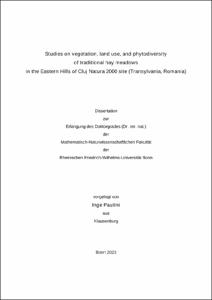Studies on vegetation, land use, and phytodiversity of traditional hay meadows in the Eastern Hills of Cluj Natura 2000 site (Transylvania, Romania)

Studies on vegetation, land use, and phytodiversity of traditional hay meadows in the Eastern Hills of Cluj Natura 2000 site (Transylvania, Romania)

| dc.contributor.advisor | Weigend, Maximilian | |
| dc.contributor.author | Paulini, Inge | |
| dc.date.accessioned | 2024-04-17T12:01:06Z | |
| dc.date.available | 2024-04-17T12:01:06Z | |
| dc.date.issued | 17.04.2024 | |
| dc.identifier.uri | https://hdl.handle.net/20.500.11811/11496 | |
| dc.description.abstract | In the peri-Carpathian region some basiphilous semi-dry grasslands (meadow steppes) feature exceptionally high values of vascular plant species richness, especially when managed as hay meadows. The goal of this thesis was to survey traditional hay meadows in the Eastern Hills of Cluj Natura 2000 site (Transylvania, Romania), which were suspected to contain these very species-rich types of semi-dry grasslands as well. In addition to vegetation and phytodiversity data, the research included aspects of land tenure and land use change. This interdisciplinary approach aimed to show which aspects are important to consider for a successful conservation of Transylvania’s cultural landscapes and their biodiversity. The study was carried out in three traditional hay meadows in the communes Dabâca and Borşa, which cover around 300 hectares in total. In a phytosociological survey with priority on meadow steppes and Molinia meadows, Braun-Blanquet-relevés were carried out in the years 2009-2013. The historical land use and tenure from 1880 onwards was determined through cadastral maps. Interviews provided information about the traditional meadow management and land use changes in the post-communist era. In the years 2010-2014 the mown plots were mapped in the field. In the meadow steppes, regularly mown stands were compared with unmown or permanently grazed stands regarding their plant diversity and vegetation, using nested-plot series. Four of nine identified plant communities belong to semi-dry basiphilous grasslands. This includes the Polygalo majoris-Brachypodietum pinnati Wagner 1941 with the highest mean vascular plant species richness (61 species / 10 m2) and the Brachypodio pinnati-Molinietum arundinaceae Klika 1939, which is often associated with the highest values of plant species richness on a small scale. Furthermore, presumably the first description for Romania of the Molinietum caeruleae Koch 1926 which explicitly mentions Molinia arundinacea is provided. The meadows have been managed continuously as hay meadows for a minimum of 140 years. Their tenure pattern consists of hundreds of small, narrow plots, which has its origin at least 100 years ago. The meadows were traditionally mown once a year between June to August, were not fertilised and were grazed in spring and autumn. Abandonment of mowing, the advent of year-round sheep grazing, and the resulting scrub encroachment are the most important land use changes in the post-communist era. One of the worldwide highest values of vascular plant species richness on 0.01 m2 was found (26 species). Short-term abandonment of mowing in the steppe meadows resulted in a decrease of plant species richness and a shift in species composition within the typical species inventory. Conversion of the meadows to permanent sheep pastures led to a decrease in plant species richness and evenness and a replacement of typical meadow species through species of other communities, including ruderal vegetation. This thesis provides a holistic view on the traditional hay meadows of the study area and reveals possible factors contributing to the high plant diversity of the meadow steppes. Management measures and strategies are poposed which can help to preserve the meadows in the future. | en |
| dc.language.iso | eng | |
| dc.rights | Namensnennung 4.0 International | |
| dc.rights.uri | http://creativecommons.org/licenses/by/4.0/ | |
| dc.subject | Vegetation | |
| dc.subject | Grasland | |
| dc.subject | Grünland | |
| dc.subject | naturnah | |
| dc.subject | Halbtrockenrasen | |
| dc.subject | Heuwiese | |
| dc.subject | Wiesensteppe | |
| dc.subject | Biodiversität | |
| dc.subject | Pflanzenartenreichtum | |
| dc.subject | Nutzungskontinuität | |
| dc.subject | Mahd | |
| dc.subject | Beweidung | |
| dc.subject | Mahdaufgabe | |
| dc.subject | Besitzstruktur | |
| dc.subject | historische Landnutzung | |
| dc.subject | Kulturlandschaft | |
| dc.subject | Klausenburger Hügelland | |
| dc.subject | ROSCI0295 | |
| dc.subject | Molinia arundinacea | |
| dc.subject | Molinietum caeruleae | |
| dc.subject | Brachypodio pinnati-Molinietum arundinaceae | |
| dc.subject | Polygalo majoris-Brachypodietum pinnati | |
| dc.subject | Phengaris | |
| dc.subject | Maculinea | |
| dc.subject | vegetation | |
| dc.subject | grassland | |
| dc.subject | semi-natural | |
| dc.subject | semi-dry grassland | |
| dc.subject | hay meadow | |
| dc.subject | meadow steppe | |
| dc.subject | biodiversity | |
| dc.subject | plant species richness | |
| dc.subject | nested plot | |
| dc.subject | land use continuity | |
| dc.subject | mowing | |
| dc.subject | grazing | |
| dc.subject | mowing abandonment | |
| dc.subject | land tenure | |
| dc.subject | historical land use | |
| dc.subject | cultural landscape | |
| dc.subject | Hills of Cluj | |
| dc.subject.ddc | 580 Pflanzen (Botanik) | |
| dc.title | Studies on vegetation, land use, and phytodiversity of traditional hay meadows in the Eastern Hills of Cluj Natura 2000 site (Transylvania, Romania) | |
| dc.type | Dissertation oder Habilitation | |
| dc.identifier.doi | https://doi.org/10.48565/bonndoc-268 | |
| dc.publisher.name | Universitäts- und Landesbibliothek Bonn | |
| dc.publisher.location | Bonn | |
| dc.rights.accessRights | openAccess | |
| dc.identifier.urn | https://nbn-resolving.org/urn:nbn:de:hbz:5-75717 | |
| ulbbn.pubtype | Erstveröffentlichung | |
| ulbbnediss.affiliation.name | Rheinische Friedrich-Wilhelms-Universität Bonn | |
| ulbbnediss.affiliation.location | Bonn | |
| ulbbnediss.thesis.level | Dissertation | |
| ulbbnediss.dissID | 7571 | |
| ulbbnediss.date.accepted | 07.02.2024 | |
| ulbbnediss.institute | Mathematisch-Naturwissenschaftliche Fakultät : Fachgruppe Biologie / Institut für Zelluläre und Molekulare Botanik (IZMB) | |
| ulbbnediss.fakultaet | Mathematisch-Naturwissenschaftliche Fakultät | |
| dc.contributor.coReferee | Fischer, Eberhard |
Files in this item
This item appears in the following Collection(s)
-
E-Dissertationen (4400)






